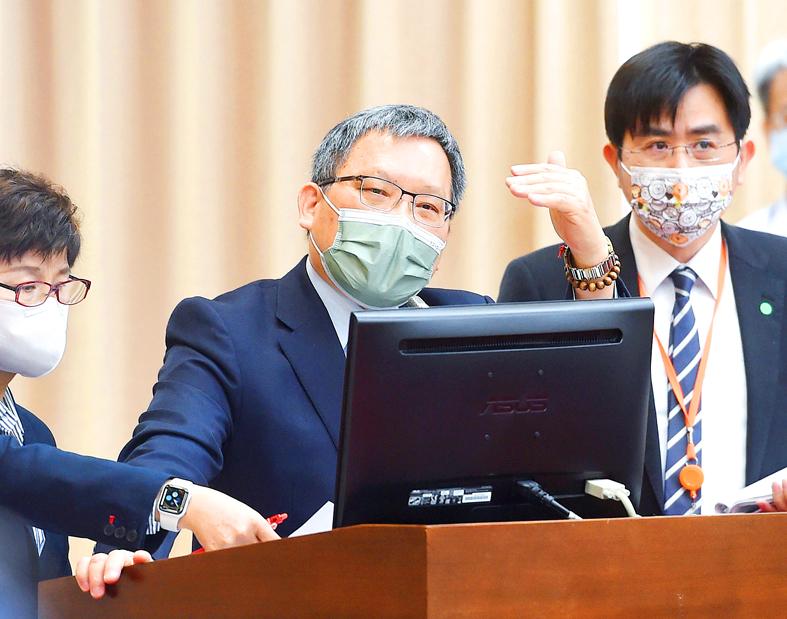The state coffers could benefit from increases in property tax revenue next year, as major municipalities are raising taxes on people who own multiple homes in a bid to discourage property hoarding, Minister of Finance Su Jain-rong (蘇建榮) said yesterday.
Su made the remark at a meeting of the legislature’s Finance Committee after Taoyuan, Taichung, Tainan, Kaohsiung, Hsinchu County and Hsinchu City made known their intentions to raise property tax rates to 3.6 percent on fourth, fifth or sixth homes, effective in July, to ease house hoarding.
Su estimates the additional property tax revenue, due in May, to be slightly less than NT$10 billion (US$351.42 million) per year.

Photo: Fang Pin-chao, Taipei Times
Taipei has set property tax rates at 2.4 percent for second homes and 3.6 percent for third homes. New Taipei City said it would make changes, but has not disclosed percentages. It is the responsibility of local administrators to set property tax rates.
The ministry would review property taxes in May next year to determine if further revisions are necessary, Su said.
Tax bases could also be discussed, he said.
The ministry could monitor how local governments implement property taxes, Su said, adding that Changhua and Kinmen counties have not adjusted property taxes in the past 40 years.
Taxes on multiple homes could help deter rises in housing prices that are caused by property speculation, but could prove ineffective in reversing cost-driven price increases, Su said, adding that developers have attributed ongoing property price hikes partly to soaring building material prices.
The ministry is enhancing its crackdown on tax evasion stemming from owners who have a minimum of 10 homes, with the effort likely extending later to owners with a minimum of five homes, Su said.

Taiwan will prioritize the development of silicon photonics by taking advantage of its strength in the semiconductor industry to build another shield to protect the local economy, National Development Council (NDC) Minister Paul Liu (劉鏡清) said yesterday. Speaking at a meeting of the legislature’s Economics Committee, Liu said Taiwan already has the artificial intelligence (AI) industry as a shield, after the semiconductor industry, to safeguard the country, and is looking at new unique fields to build more economic shields. While Taiwan will further strengthen its existing shields, over the longer term, the country is determined to focus on such potential segments as

UNCERTAINTY: Innolux activated a stringent supply chain management mechanism, as it did during the COVID-19 pandemic, to ensure optimal inventory levels for customers Flat-panel display makers AUO Corp (友達) and Innolux Corp (群創) yesterday said that about 12 to 20 percent of their display business is at risk of potential US tariffs and that they would relocate production or shipment destinations to mitigate the levies’ effects. US tariffs would have a direct impact of US$200 million on AUO’s revenue, company chairman Paul Peng (彭雙浪) told reporters on the sidelines of the Touch Taiwan trade show in Taipei yesterday. That would make up about 12 percent of the company’s overall revenue. To cope with the tariff uncertainty, AUO plans to allocate its production to manufacturing facilities in

COLLABORATION: Given Taiwan’s key position in global supply chains, the US firm is discussing strategies with local partners and clients to deal with global uncertainties Advanced Micro Devices Inc (AMD) yesterday said it is meeting with local ecosystem partners, including Taiwan Semiconductor Manufacturing Co (TSMC, 台積電), to discuss strategies, including long-term manufacturing, to navigate uncertainties such as US tariffs, as Taiwan occupies an important position in global supply chains. AMD chief executive officer Lisa Su (蘇姿丰) told reporters that Taiwan is an important part of the chip designer’s ecosystem and she is discussing with partners and customers in Taiwan to forge strong collaborations on different areas during this critical period. AMD has just become the first artificial-intelligence (AI) server chip customer of TSMC to utilize its advanced

While China’s leaders use their economic and political might to fight US President Donald Trump’s trade war “to the end,” its army of social media soldiers are embarking on a more humorous campaign online. Trump’s tariff blitz has seen Washington and Beijing impose eye-watering duties on imports from the other, fanning a standoff between the economic superpowers that has sparked global recession fears and sent markets into a tailspin. Trump says his policy is a response to years of being “ripped off” by other countries and aims to bring manufacturing to the US, forcing companies to employ US workers. However, China’s online warriors